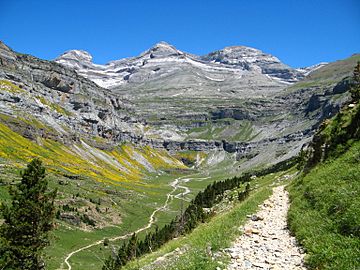Pyrénées – Mont Perdu World Heritage Site facts for kids
| UNESCO World Heritage Site | |
|---|---|
 |
|
| Location | Pyrenees in France and Spain |
| Criteria | Cultural and Natural: (iii), (iv), (v), (vii), (viii) |
| Inscription | 1997 (21st Session) |
| Extensions | 1999 |
| Area | 30,639 ha (75,710 acres) |
The Pyrénées – Mont Perdu World Heritage Site is a special place that crosses the border between Spain and France. It's located in the Pyrenees mountains. The highest point, Monte Perdido (which means "Lost Mountain" in French), is on the Spanish side. This amazing area was named a World Heritage Site in 1997. Later, in 1999, it was made even bigger to include the town of Gèdre in France.
This site includes two national parks that are next to each other. On the Spanish side, you'll find the whole Ordesa y Monte Perdido National Park. On the French side, it covers the eastern part of the Pyrénées Occidentales National Park. In total, this World Heritage Site is about 30,639 hectares, which is a huge area!
Contents
Exploring the Pyrenees – Mont Perdu Site
This World Heritage Site is centered around Monte Perdido. It's famous for its incredible landforms. You can see two of Europe's biggest canyons on the Spanish side. On the French side, there are huge, curved rock walls called cirques. As you explore the mountain slopes, you'll find beautiful meadows, hidden caves, thick forests, and clear lakes.
Nature and Wildlife in the Pyrenees
While other mountain ranges like the Alps have more different kinds of plants and animals, the Pyrenees are special. They haven't been changed as much by people as other European mountains. This means they still have many natural areas.
A Look Back: Human History in the Mountains
People have lived in the Pyrenees for a very long time. We know this because of ancient signs left behind. For example, there's a dolmen (an old stone structure) on the Spanish side. You can also find stone circles in the Cirque de Gavarnie in France. These show that humans have been here since the Stone Age.
Villages and towns started to appear in the Middle Ages. They were built in the valleys around Monte Perdido. People used the water running down from the mountains to water their fields. A unique way of life developed here, focused on raising livestock. Farmers would move their animals up and down the mountain slopes depending on the season. This practice is called "transhumance".
Sharing the Mountains: A Unique Border Life
Because the communities in the Pyrenees are so connected, they often have more in common with their neighbors across the border than with the rest of their own country. This has led to a special system. Spanish farmers can often graze their animals on the French side, and French farmers can do the same in Spain. This shows how people in this region have worked together for centuries.
See also
 In Spanish: Pirineos-Monte Perdido para niños
In Spanish: Pirineos-Monte Perdido para niños


